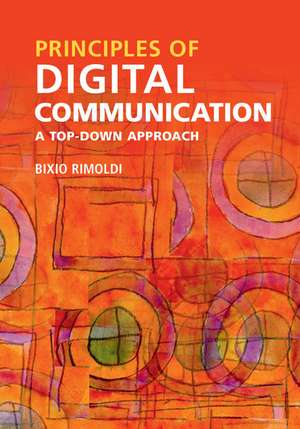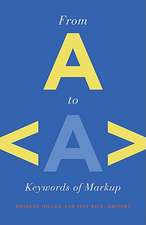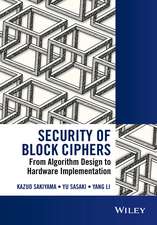Principles of Digital Communication: A Top-Down Approach
Autor Bixio Rimoldien Limba Engleză Hardback – 20 ian 2016
Preț: 434.95 lei
Preț vechi: 488.71 lei
-11% Nou
Puncte Express: 652
Preț estimativ în valută:
83.24€ • 86.79$ • 69.18£
83.24€ • 86.79$ • 69.18£
Carte disponibilă
Livrare economică 28 februarie-14 martie
Preluare comenzi: 021 569.72.76
Specificații
ISBN-13: 9781107116450
ISBN-10: 1107116457
Pagini: 269
Ilustrații: 124 b/w illus. 1 table 128 exercises
Dimensiuni: 180 x 253 x 18 mm
Greutate: 0.75 kg
Editura: Cambridge University Press
Colecția Cambridge University Press
Locul publicării:New York, United States
ISBN-10: 1107116457
Pagini: 269
Ilustrații: 124 b/w illus. 1 table 128 exercises
Dimensiuni: 180 x 253 x 18 mm
Greutate: 0.75 kg
Editura: Cambridge University Press
Colecția Cambridge University Press
Locul publicării:New York, United States
Cuprins
1. Introduction and objectives; 2. Receiver design for discrete-time observations: first layer; 3. Receiver design for the continuous-time AWGN channel: second layer; 4. Signal design trade-offs; 5. Symbol-by-symbol on a pulse train: second layer revisited; 6. Convolutional coding and Viterbi decoding: first layer revisited; 7. Passband communication via up/down conversion: third layer.
Recenzii
'This is an excellent introductory book on digital communications theory that is suitable for advanced undergraduate students and/or first-year graduate students, or alternatively for self-study. It achieves a nice degree of rigor in a clear, gentle, and student-friendly manner. The exercises alone are worth the price of the book.' Dave Forney, Massachusetts Institute of Technology
'[This] is a special and most attractive text … It is special in that it addresses the most basic features of digital communications in an attractive and simple way, thereby facilitating the teaching of these fundamental aspects within a single semester. This is done without compromising the required mathematical and statistical framework. This remarkable achievement is the outcome of many years of excellent teaching of undergraduate and graduate digital communication courses, by the author … All in all, this extremely well structured text is an excellent book for a first course on digital communications. It covers exactly what is needed and it does so in a simple and rigorous manner that the students and the tutor will appreciate. The achieved balance between theoretical and practical aspects makes this text well suited for students with either inclinations to an industrial or an academic career.' Shlomo Shamai, Technion, Israel Institute of Technology
'The Rimoldi text is perfect for a beginning mezzanine-level course in digital communications. The logical three-layer - discrete-time, continuous-time, passband - approach to the problem of communication system design greatly enhances understanding. Numerous examples, problems, and MATLAB exercises make the book both student and instructor friendly. My discussions with the author about the book's development have convinced me that it's been a labor of love. The completed manuscript clearly bears this out.' Dan Costello, University of Notre Dame
'[This] is a special and most attractive text … It is special in that it addresses the most basic features of digital communications in an attractive and simple way, thereby facilitating the teaching of these fundamental aspects within a single semester. This is done without compromising the required mathematical and statistical framework. This remarkable achievement is the outcome of many years of excellent teaching of undergraduate and graduate digital communication courses, by the author … All in all, this extremely well structured text is an excellent book for a first course on digital communications. It covers exactly what is needed and it does so in a simple and rigorous manner that the students and the tutor will appreciate. The achieved balance between theoretical and practical aspects makes this text well suited for students with either inclinations to an industrial or an academic career.' Shlomo Shamai, Technion, Israel Institute of Technology
'The Rimoldi text is perfect for a beginning mezzanine-level course in digital communications. The logical three-layer - discrete-time, continuous-time, passband - approach to the problem of communication system design greatly enhances understanding. Numerous examples, problems, and MATLAB exercises make the book both student and instructor friendly. My discussions with the author about the book's development have convinced me that it's been a labor of love. The completed manuscript clearly bears this out.' Dan Costello, University of Notre Dame
Notă biografică
Descriere
A comprehensive text that takes a unique top-down approach to teaching the fundamentals of digital communication for a one-semester course.


















